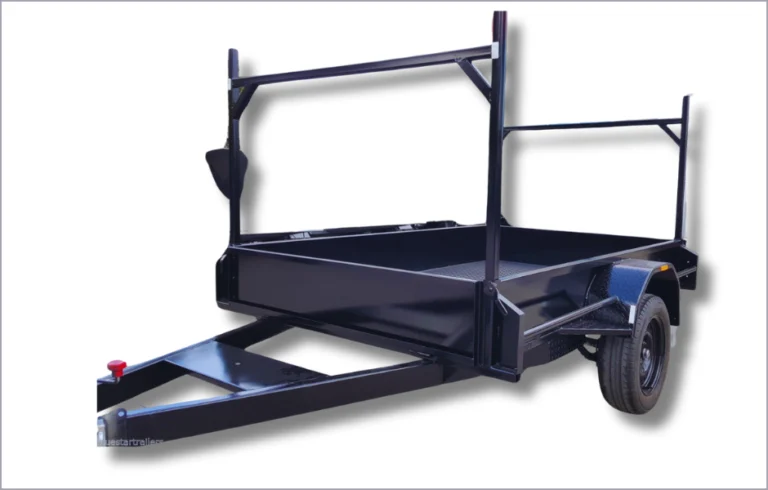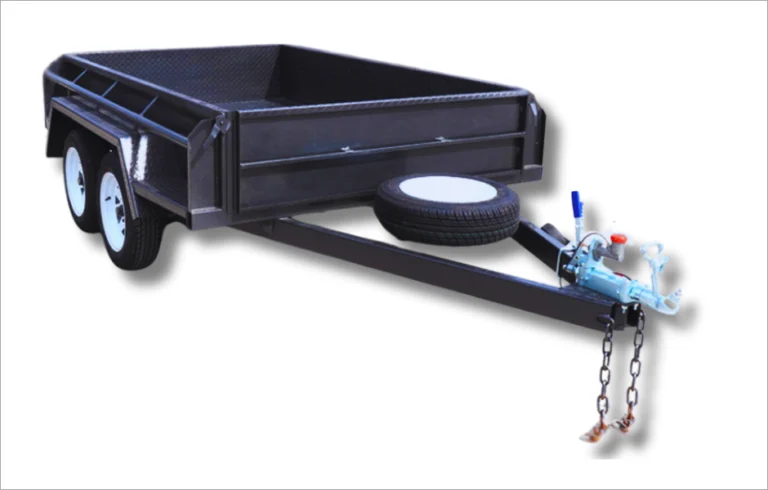Single Axle Trailers Vs Tandem Axle Trailers: Which Will Work Best for Your Hauling Needs?
Introduction: The Axle Question Every Buyer Faces
Every trailer buyer in Victoria eventually faces the same question: Should I choose a single axle or a tandem axle trailer? At first glance, it seems like an easy decision. One axle means two wheels, and two axles mean four. However, anyone who has towed down the Monash Freeway or backed into a Pakenham job site knows the differences go far beyond just wheel count.
The axle setup impacts how much weight you can carry, the stability of your trailer at highway speeds, the maintenance costs, and how easy it is to reverse into a tight laneway in Melbourne’s inner suburbs. Choose the wrong type, and you could spend years dealing with limitations. Choose the right one, and your trailer becomes the workhorse you count on every week.
What Is a Single Axle Trailer?
A solo axle trailer is simply designed: one axle with wheels mounted on it.
- Load capacity: Generally 1,500-2,000 kg.
- Best suited for: lighter tasks, weekend hobby pulling or landscaping runs.
- Design: Smaller and lighter frame means that towing smaller capacity vehicles is simpler.

Advantages
Single axle trailers have a number of benefits of urban dwelling. Narrower frame can travel through smaller streets faster and easily fit in driveways; their initial cost–tend to be thousands lower compared to tandem designs–is lower; and long term tyre and brake cost savings will be substantial.
Limitations
Capacity. Stability. Those are usually the weak areas. Drive a solo axle too hard and you’ll likely see increased sway at speed from differential loading; furthermore, its lighter construction will not last as long under normal abuse.
Want to compare how much more tandem axles can carry? Check our Tandem Axle Trailers: Weight Capacity User Guide for detailed specs.
Tandem Axle Trailers Offer Power
A tandem axle trailer has twice the axles and wheels of the last one and is now a completely different beast.
- Load Capacity: usually between 2,500-4,500 kg.
- Best suited for: builders, farmers or operators hauling heavy materials on a daily basis.
- Construction: Heavy-duty chassis usually with electric brakes.

Benefits
Tandem trailers can be considered four-wheel drives in trailer guise; rugged, stable, and designed for hard work. When carrying heavier loads on highways or carrying over less-smooth terrain, tandems are more secure on highways, carry weight more evenly over their load, and wear longer under frequent use.
Restrictions
All that horsepower has a cost. They demand more towing capacity from your vehicle, cost more to purchase and maintain, use twice the tyres, bearings and brake checks than you anticipated and probably will never live up to their full potential if used only once every few months for waste garden haulage.
Capacity & Performance: Side-by-Side
| Feature | Single Axle Trailer | Tandem Axle Trailer |
|---|---|---|
| Load Capacity | 1,500–2,000 kg | 2,500–4,500 kg |
| Stability | Agile but less stable at speed | Greater stability, smoother highway towing |
| Braking | Override brakes for compliance | Electric brakes (mandatory for vehicles over 2,000 kg) |
| Maneuverability | Easy in tight spaces | Harder to reverse in city traffic |
| Maintenance | Less expensive upkeep with fewer parts | Higher upkeep, more wheels and brakes to service |
Short vs Long Term Costs in Real Estate Development: the Equation
Single axle models begin at $2,000-$3,500. Maintenance needs stay lower with only two tires to keep up with and a more straightforward brake system to contend with.
Tandems: Plan on spending $4,500-$10,000 based on size and construction. While their initial expense is often overwhelming, tandems typically paid dividends in the long run by having less chance of collapsing under stress for less downtime for daily haulers.
More important than price now is what product or service will be doing a good job five years from now.
Which Trailer Accessories are Compatible with the Task Desired in This Trailer?
- Single Axle Trailers: Best suited for landscape maintenance rounds, garden debris pickup, lightweight equipment delivery and weekend vehicles like ATVs, bicycles or camping equipment.
- Tandem Axles: Employed to haul bulk gravel, heavy equipment, produce, enclosed trailers and long distance towing.
In simple terms: single axles are best for city and light duty work while tandems are best for rural farming or heavy construction applications.
Legal & Safety Regulations in Victoria – And How to Choose the Right Options
Victoria Roads says that choosing an axle configuration that’s right and remaining compliant and safe are both major parts of having a trailer in Victoria.
- Trailers over 750 kg GVM should be equipped with brakes.
- As soon as you reach 2,000 kg GVM, electric brakes are required.
- Legal maximum width: 2.5 metres
- Legal maximum height: 4.3 metres
- Every trailer is also required to carry ADR-approved lighting and reflectors.
These regulations aren’t merely in place to tick bureaucratic boxes but for a higher purpose ensuring the safety of every road user. Perhaps the most common error we find purchasers of heavy-duty tandem trailers make is buying it without first asking the question of whether their ute will be able to tow it safely. Technically within the law, your vehicle would render itself unroadworthy without your knowledge and in the event of a collision would see you without insurance or coverage.
How to Choose: The Buyer’s Checklist
Ask yourself:
- What will be the heaviest load that you routinely tow?
- Are agility in Melbourne’s tight urban streets more important to you, or stability on highways or regional hauls?
- Will the trailer only be used occasionally such as weekend projects, or five days per week at work?
- Ultimately, is your tow vehicle capable of safely towing under full load conditions?
Whether your job includes light or occasional hauling requirements, a single axle trailer can offer adequate agility while minimizing expense. But for ongoing hauling operations like gravel haulage or farm produce transportation, tandem axle trailers can be more economical and safer in the long run. Although they are more costly in the beginning, their longer lifespan and lower rates of break-down justify their higher initial cost.
Quick Reference: Compliance vs. Buyer Checklist
| Victoria Roads Legal Requirements | Buyer Considerations Before Selecting |
|---|---|
| Trailers over 750 kg GVM must include brakes | What will your average load be when towing? |
| Electric brakes required for trailers over 2,000 kg | Do you prioritise agility or stability? |
| Maximum width: 2.5 metres | Will your trailer be used occasionally or daily? |
| Maximum height: 4.3 metres | Is your tow vehicle rated for tandem towing? |
| ADR-compliant lighting and reflectors required | Do you prefer upfront savings or long-term value? |
Urban Trailer’s Expert Opinion
We at Urban Trailer have witnessed too many purchasers selecting the wrong unit to save a couple of bucks, only to return when their single axle blows under loads it was not designed to support.
- Select a single axle trailer if you have light-duty work and require agility in and around Melbourne.
- Choose a tandem axle trailer if you’re a farmer, builder, or contractor who lives and dies by load capacity and stability.
And if you’re exploring advanced setups, don’t miss our in-depth breakdown of Hydraulic Tipper Trailers they combine tandem strength with hydraulic efficiency for serious hauling.
Conclusion
The argument about single versus tandem axle trailers is not which one is “best”—it’s which one suits the way you work.
- Single axles are quick and inexpensive.
- Tandems are designed to handle the heavy tasks with no sweat.
For Melbourne tradies and regional farmers alike, the proper trailer becomes an extension of themselves—an integral part of every job. Visit our complete selection of single and tandem axle trailers at Urban Trailer, and pick a configuration that’s designed for your workload, not against it.
FAQ’S
Single axles are lighter, cheaper, and better for small loads. Tandems are heavier, more stable, and built for bigger jobs.
2. How much weight can a tandem axle trailer carry?
Typically between 2,500–4,500 kg, depending on design and registration class.
3. Are tandem axle trailers harder to tow?
They’re heavier, but also more stable. On highways, tandems actually feel smoother than single axles.
4. Which trailer lasts longer?
Tandems generally last longer under heavy use because the load is shared across more tyres and axles.
5. Is a tandem trailer worth the extra cost?
If you regularly haul more than 1,500 kg or travel long distances, yes—it pays off in durability and safety.



